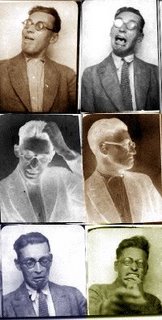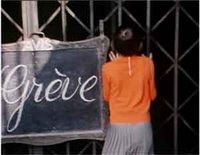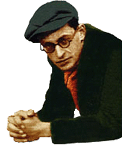 by
by 
{1903–76} French poet, novelist, and publisher - a precursor of postmodernism. Raymond Queneau was an advocate of surrealism during the middle and late 1920s. He used in his novels and poems colloquial speech and phonetic spellings.
One of Queneau's main delights is playing with language and Zazie is exemplary, employing phonetic spelling and phraseology. The story's first word is "Doukipudonktan?" - a compression of D'ou qu'ils puent donc tant? ("How canaystinksotho?")
 Published in 1959, Zazie dans le Métro won the Prix de l'humour noir. The novel was adapted for the screen by Louis Malle in 1960, at the height of the Nouvelle Vague movement in French film.
Published in 1959, Zazie dans le Métro won the Prix de l'humour noir. The novel was adapted for the screen by Louis Malle in 1960, at the height of the Nouvelle Vague movement in French film.In this imaginative adaptation of Queneau’s novel , ten-year-old Zazie is brought to Paris to stay with her uncle Gabriel.
 Zazie’s one desire is to ride on the Métro, but it is immobilized by a strike. Malle is faithful to Raymond Queneau novel: the episodes and dialogue are intact, with visual illustrations added when required, often to considerable effect.
Zazie’s one desire is to ride on the Métro, but it is immobilized by a strike. Malle is faithful to Raymond Queneau novel: the episodes and dialogue are intact, with visual illustrations added when required, often to considerable effect.Again Queneau writes in a semiserious way and uses widely
 dialogue, meaningless everyday language, swearwords, and phonetic spelling - Zazie drinks "cacocalos" and wears "bloudjinnzes".
dialogue, meaningless everyday language, swearwords, and phonetic spelling - Zazie drinks "cacocalos" and wears "bloudjinnzes".When her mother comes to collect her, she asks
- "did you see the métro?"
- "No"
- "What did you do, then?"
- "I grew up."
English Editions in print ISBN 0142180041 (Penguin paperback, translated by Barbara Wright)







2 + Comments:
Je vais laisser un commentaire car c'est mon livre PREFERE!!! Je l'ai tellement lu, tellement vu l'adaptation cinematographique de Louis Malle et tellement dit "Mon cul" pendant mon adolescence que mes amis m'appellait Zazie -C'etait avant la chanteuse!!! Il en existe une bonne traduction en anglais chez Penguin.
Oups... Je n'avais pas lu ce que tu avais ecrit entre parentheses a la fin...
Post a Comment
Home